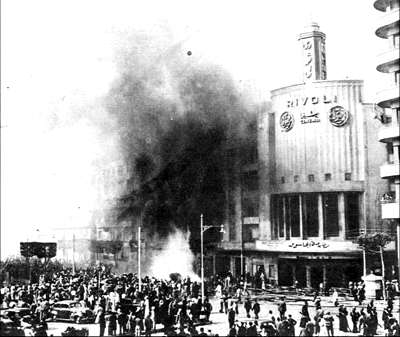Parallels: The Cairo Fire

This week I have been reminded of the January 1952 Cairo fire, a riot by poor Egyptians targeting foreigners and the wealthy that was manipulated by the police and the British. From the conclusion of Anne-Claire Kerboeuf's article in Cairo Times, Volume 6 Issue 20:
More than just a fire, 26 January 1952 was an unprecedented national mobilization that for the most part was organized at the grassroots of Egyptian society. That mobilization was undermined by political, economic and social rivalries among the Egyptian elite that were exploited by the British. Those rivalries weakened the whole state apparatus inasmuch as high level officials used them for their own political intrigues and to satisfy their personal interests.Thus, Fouad Serageddin allowed the organization of a riot by paying Ahmad Hussein and did not take elementary precautions to contain the predictable overflow of 26 January. Notably, he deployed very few police officers in Cairo ahead of the demonstrations, unlike the governor of Alexandria. As for King Farouq, he kept 800 police and army chiefs in his palace during the riot for a banquet to celebrate the birth of his son. He also delayed giving the army to go-ahead to intervene.By organizing the riot, Ahmad Hussein may have served the short-term interests of the British, but not their long-term ones. Unlike other political actors, he had understood that the regime was on its death throes and that one blow would suffice to make it fall. That fatal blow was the Cairo fire, which pitted security forces allied with civilians against the regime. Hussein successfully discredited the elite, which now inspired violence instead of respect.After 26 January, none of the three governments formed in the space of six months was able to restore order. Yet, there was no opposition force that was capable of seizing power--whether among the traditional parties or the parties and groups that existed outside of parliament. The Muslim Brothers were still weakened by the death of their founder and supreme guide, Hassan Al Banna, and government repression. Misr Al Fatah, although never as influential as between 1950 and 1952 (particularly through its newspapers), was not a mass-based party. However, both of these organizations had links with the Free Officers and were ready to back them. After 26 January 1952, the road for the army was clear.
To read with this in mind: The Egyptian Army's Hamlet Moment.
